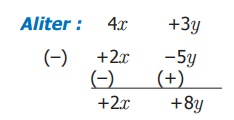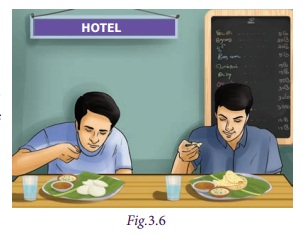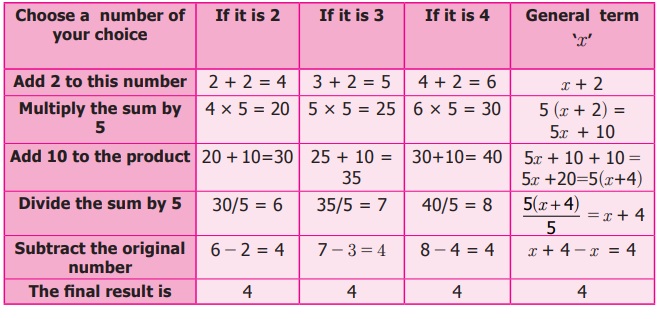Algebra | Term 1 Chapter 3 | 7th Maths - Addition and Subtraction of Algebraic expressions | 7th Maths : Term 1 Unit 3 : Algebra
Chapter: 7th Maths : Term 1 Unit 3 : Algebra
Addition and Subtraction of Algebraic expressions
Addition
and Subtraction of Algebraic expressions
We have discussed about algebraic expressions. Now,
let us see how to add and subtract algebraic expressions.
Situation: Kannan has some number of beads and
Aravind has 20 beads more than Kannan.
Kavitha says that she has 3 more beads than the number of beads that Kannan and
Aravind together have. How will you find the number of beads that Kavitha have.
Now we see that even though 3 persons are involved
with 3 unknown quantities, we make use of one variable, since all the three variables
are related.
Let that one variable be x which represents the number of beads that Kannan has.
Aravind has 20 more beads than Kannan. That is x + 20.
Kavitha has 3 beads more than Kannan and Aravind
have together. So, the number of beads that Kavitha has is given by x+x+20+3.
Now, we change the situation. Instead of Aravind
has 20 more beads than Kannan, suppose Aravind has 20 beads less than Kannan.
If Kavitha has 3 beads more than what Kannan and
Aravind have together, then find the number of beads that Kavitha has.
Now, Aravind has x – 20 beads. So, the number of beads that Kavitha has, is given by x +
x – 20 + 3.
For example, to add 8ab, 4ab and 2ab, where ab is variable, we add the co-efficients alone, that
is 8ab + 4ab + 2ab = (8 + 4 + 2) ab = 14 ab = 14ab.
In the same way, we can add the algebraic expressions.
Let us try to add the expressions 11y + 7 and 5y − 3, where 11y and 5y are like terms with a variable y and 7 and −3 are
Hence, (11y + 7) + (5y − 3) = [11y + 5y] + [7 + ( − 3)]
= [(11 +
5) y] + (7 − 3)]
= 16y + 4.
Try this
Add the terms:
i) 3p,
14p
3p + 14p = 17p
ii) m,
12m, 21m
m + 12m + 21m = 34m
iii) 11abc,
5abc
11 abc + 5 abc = 16 abc
iv) 12y,
−y
12y + –y = 11y
v) 4x,
2x, − 7x
4x + 2x + – 7x
6x – 7x = –x
Example 3.5
Add the expressions: (i) pq −1 and 3pq + 2 (ii) 8x + 3 and 1 − 7x
Solution
(i) (pq − 1) + (3pq + 2) = (pq + 3pq) + ( − 1 + 2)
= (1 + 3)pq + 1
= 4pq + 1
(ii) (8x + 3) + (1 − 7x) = 8x + 3 + 1 − 7x
= (8x − 7x) + (3 + 1)
= (8 − 7)
x + 4
= x + 4.
Subtraction of a term can be looked as addition
of its additive inverse as we saw in subtraction of integers. To understand subtraction
of algebraic expression, let us consider subtraction of algebraic expression with
one term.
For example, to subtract 6y from 12y, we can add 12y and (− 6y).
Thus we have, 12y + ( − 6y) = 12y − 6y
= (12 − 6)y = 6y.
Now, let us subtract – mn from 3mn. Additive inverse of – mn is mn. Hence, we have to add mn with 3mn. Thus, 3mn + mn = (3 + 1)mn = 4mn.
Similarly, we can subtract two algebraic expressions.
For example, to subtract 13a − 2 from 25a + 11, we have to add
the additive inverse of 13a – 2 with 25a + 11.
Additive inverse of 13a–2 is −(13a−2) = −13a + 2
Therefore, 25a + 11 − (13a – 2) = (25a + 11) + (−13a +2)
= (25a + 11) + (−13a +2)
= (25a − 13a) + (11 + 2)
= 12a + 13
Note
1. Subtracting
4y is the same as adding – 4y and subtracting – 11x is the same as adding 11x.
2. We
know that, – 3 is the additive inverse of 3. In the same way – x is an additive inverse of x. Hence, x, – x are equal in numerical value; but
opposite in sign.
Therefore, x+(–x) = 0. But, x – (–x) = x+x = 2x.
Example 3.6
Subtract: i) 7pq from 11pq ii) – a from a iii) 5x + 7 from 21x + 9
Solution
(i) 11pq – 7pq. Additive inverse of 7pq is − 7pq
11pq + ( − 7pq) = 11pq − 7pq = (11 − 7)pq = 4pq
(ii) a – (–a). Additive inverse of −a is a.
So, a + a = 2a
(iii) 21x + 9 – (5x + 7). Additive inverse of 5x + 7 is – (5x + 7).
(21x + 9) + [– (5x + 7)] = (21x + 9) – (5x + 7)
= 21x + 9 − 5x – 7
= (21 − 5)x + (9 − 7)
= 16x + 2.
Think
3x + (y − x) = 3x + y − x. But, 3x − (y − x) ≠ 3x − y − x.
Why?.
Example 3.7
Simplify:100x + 99y – 98z + 10x + 10y + 10z – x – y + z
Solution
In the given algebraic expression, x,y,z are the variables.
Let us group the like terms.
100x + 99y − 98z + 10x + 10y + 10z − x − y + z
= (100x + 10x − x) + (99y + 10y − y) + ( −98z + 10z + z)
= (100 + 10 − 1)x + (99 + 10 − 1)y + ( −98 + 10 + 1)z
= (110 −
1)x + (109 − 1)y + ( −98 + 11)z
= 109x + 108y + ( −87)z
= 109x + 108y − 87z.
Note
For adding or subtracting algebraic
expressions, we can write the like terms one after the other horizontally by using
brackets or one below the other vertically.
Example 3.8
i) Add: 3x − 4y + z and 2x − z + 3y ii) Subtract 2x − 5y from 4x + 3y
Solution
(i) (3x − 4y + z) + (2x − z + 3y)
= (3x + 2x) + ( −4y + 3y) + (z − z)
= (3 + 2)x + ( −4 + 3)y + (1 − 1)z
= 5x − 1y + 0z
= 5x − y.

(i) (4x + 3y) − (2x − 5y)
= (4x + 3y) + ( −2x + 5y)
= (4x − 2x) + (3y + 5y)
= (4 − 2)x + (3 + 5)y
= 2x + 8y.

Think
What will you get if twice a number is
subtracted from thrice the same number?
Example 3.9
Mani and his friend Mohamed went to a hotel for
dinner. Mani had 2 idlies and 2 dosas whereas Mohamed had 4 idlies and 1 dosa. If
the price of each idly and dosa is x and y respectively, then find the bill amount in x and y.

Solution
Given that, the price of one idly is ‘x’ rupees and the price of one dosa is ‘y’ rupees
So, Mani’s bill amount: (2 × x) + (2 × y) = (2x + 2y)
Mohamed’s bill amount: (4 × x) + (1 × y) = 4x + y
Therefore, the total bill amount = (2x + 2y) + (4x + y)
= (2 + 4)x + (2 + 1)y = 6x
+ 3y.
Aliter:
In total, they had 2 + 4 = 6 idlies.
i.e. 6 × x = 6x
and 2 + 1 = 3 dosas. i.e. 3 × y = 3y
Therefore, the total bill amount = 6x + 3y.
Example 3.10
Rani earns ₹ 200 on the first day and spends some amount in
the evening. She earns ₹ 300 on the second day and spends double the amount
as she spents on the first day. She earns ₹ 400 on the third day and spends 4 times the amount
as she spents on the first day. Can you give an algebraic expression of the total
amount with her, at the end of the third day.
Solution
The amount earned on the first day is ₹ 200.
Let the amount spent on the first day be ₹ x. Amount with her at the end of the first day is (200 − x).
Amount earned on the second day is ₹ 300
and the amount spent on the second day is ₹ 2x. The amount left on the second day is 300 − 2x.
Similarly, the net amount that she would have on
the third day is 400 − 4x. Therefore, the total amount that she would have
at the end of three days is (200 − x) + (300 − 2x) + (400 − 4x).
That is, 200 + 300 + 400 + ( − 1 − 2 − 4)x
= 900 + (
−7)x
Thus the required algebraic expression is 900 −
7x.
Activity
Here is a magic number trick that
you can perform using Algebra.

Everyone will end up with the same
result 4 irrespective of the number they think. Play this number game with your
friends and surprise them. We generalized the pattern in the final column using
algebraic expressions. Observe the same and create your own number game and verify
whether it works for any number by finding the general term.
Related Topics